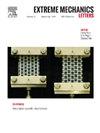用于现场机械测试的3d打印硅玻璃微机械装置(MMD)
IF 4.5
3区 工程技术
Q2 MATERIALS SCIENCE, MULTIDISCIPLINARY
引用次数: 0
摘要
基于微机电系统(MEMS)的器件为低维材料的多用途原位微/纳米机械表征提供了一种优质的解决方案,然而,它们主要是使用昂贵的自上而下硅光刻微加工工艺制造的。此前,我们证明了高分辨率自下而上的3D打印技术可用于打印此类微机械设备(MMD),但这些基于光聚合物的设备具有低模量且长期使用不太稳定。在这里,基于我们最近开发的高分辨率玻璃3D打印技术,我们展示了具有高清晰度和高性能的二氧化硅玻璃MMD。高分辨率增材制造的多功能性,加上高性能玻璃的长期机械稳定性和卓越的机械性能,使mmd的制造具有更理想的特性。这有助于对新材料进行原位微/纳米力学表征。正如我们开发的mmd所展示的那样,微纤维和纳米膜的拉伸行为展示了通过3D打印、高性能玻璃和MEMS技术的集成,为原位微/纳米机械测试提供开创性方法的潜力。本文章由计算机程序翻译,如有差异,请以英文原文为准。
3D-printed silica glass micro-mechanical device (MMD) for in situ mechanical testing
Micro-electro-mechanical systems (MEMS)-based devices offers a premium solution for versatile in situ micro-/nano- mechanical characterizations of low-dimensional materials, however, they are primarily manufactured using costly top-down silicon photolithography microfabrication processes. Previously, we demonstrated that high-resolution bottom-up 3D printing technologies can be used for printing such micro-mechanical device (MMD), but those photopolymer-based devices are of low-modulus and less stable for long-term use. Here, based on our recently developed high-resolution glass 3D printing technique, we show that silica glass MMD with high definition and performance. The versatility of high-resolution additive manufacturing, combined with the long-term mechanical stability as well as exceptional mechanical properties of high-performance glass, enables the fabrication of MMDs with more desirable characteristics. This facilitates the in-situ micro-/nano- mechanical characterizations on novel materials. The tensile behaviors of microfibers and nanofilms, as demonstrated by our developed MMDs, showcase the potential for a groundbreaking approach to in situ micro-/nano- mechanical testing through the integration of 3D printing, high-performance glass, and MEMS technologies.
求助全文
通过发布文献求助,成功后即可免费获取论文全文。
去求助
来源期刊

Extreme Mechanics Letters
Engineering-Mechanics of Materials
CiteScore
9.20
自引率
4.30%
发文量
179
审稿时长
45 days
期刊介绍:
Extreme Mechanics Letters (EML) enables rapid communication of research that highlights the role of mechanics in multi-disciplinary areas across materials science, physics, chemistry, biology, medicine and engineering. Emphasis is on the impact, depth and originality of new concepts, methods and observations at the forefront of applied sciences.
 求助内容:
求助内容: 应助结果提醒方式:
应助结果提醒方式:


